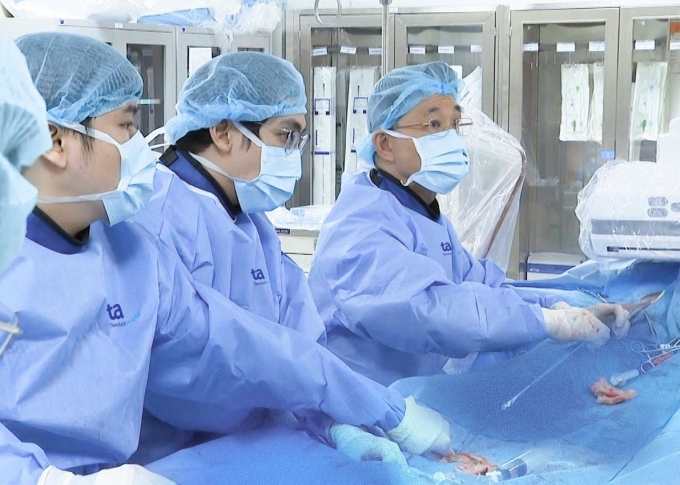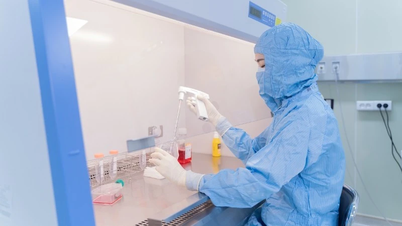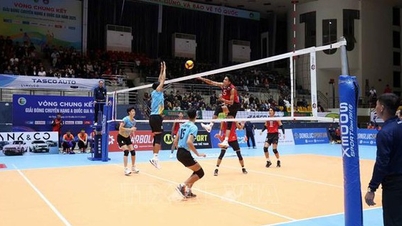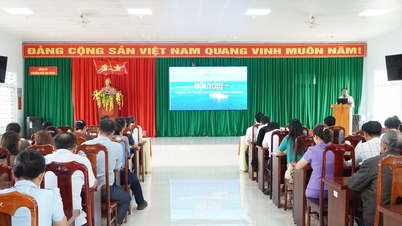Ho Chi Minh City Mr. Tu, 79 years old, had lower abdominal distension. CT scan results showed a 6.3 cm aneurysm in the abdominal aorta, at risk of rupture.
He has a history of multiple aortic aneurysms. Seven years ago, he was hospitalized for type A aortic dissection, underwent surgery to replace the ascending thoracic aorta, and had a stent placed. After surgery, he had regular check-ups in the US. Two years ago, the doctor discovered that he had an abdominal aortic aneurysm measuring 4 cm, so he was only monitored (only if it was over 5.5 cm would intervention be indicated).
This time, a CT scan at Tam Anh Hospital showed that the abdominal aortic aneurysm had increased in size to 6.3 cm. On November 8, Dr. Nguyen Anh Dung, Head of the Department of Cardiovascular and Thoracic Surgery, Cardiovascular Center, said that if not treated promptly, the aneurysm could rupture, threatening the patient's life.
Mr. Tu is elderly and has many underlying diseases such as chronic obstructive pulmonary disease (COPD), high blood pressure, diabetes, and atherosclerosis. According to Dr. Dung, the patient needs treatment for the abdominal aortic aneurysm, but there is a risk of complications during and after the procedure. In order to minimize the risk, the team decided to place a stent graft (a scaffold with a protective membrane covering it to prevent blood from escaping from the blood vessels) instead of surgery. This method shortens the procedure time, has a quick recovery, and is highly effective, suitable for elderly patients, those with poor health, or those with underlying diseases that do not qualify for open surgery.
The patient had a history of multiple aortic aneurysms, and the blood vessels supplying the patient were very vulnerable during the intervention, leading to a lack of blood supply to surrounding organs such as the kidneys, liver, intestines, and spinal cord. The stent graft placement team skillfully avoided damaging the blood vessels supplying the patient. The stent hugged the entire artery wall, adjusting the blood flow in the vessel to a normal state . The patient was discharged after three days.

Doctor Dung (far right) and his team placed a stent for the patient. Photo: Tam Anh Hospital
The aorta is the largest blood vessel in the body, carrying blood from the heart to all the other organs. An aortic aneurysm is a condition in which the artery wall weakens and bulges into a blood-filled mass. It affects men more than women. There are two common types: abdominal aortic aneurysms (accounting for about 75% of all cases) and thoracic aortic aneurysms. Some people have both.
The disease often has no symptoms. When the aneurysm grows rapidly, the patient feels deep, continuous pain in the abdomen or one side of the abdomen, back pain, and tension around the navel (like palpitations).
Dr. Dung said that nearly 90% of aneurysm rupture cases cannot be cured. Therefore, people who have symptoms of pale skin, cold hands and feet, sweating, dizziness, fainting, rapid heartbeat, difficulty breathing..., the possibility of a ruptured aneurysm needs immediate emergency care.
To prevent aortic aneurysm or prevent aneurysm rupture, patients need to avoid smoking, eat a healthy diet, keep blood pressure and cholesterol within acceptable limits, exercise regularly, and control underlying medical conditions. Everyone needs regular screening to detect the disease early.
Thu Ha
* Patient's name has been changed
| Readers ask questions about cardiovascular disease here for doctors to answer |
Source link



![[Photo] Prime Minister Pham Minh Chinh meets with South African President Matamela Cyril Ramaphosa](https://vphoto.vietnam.vn/thumb/1200x675/vietnam/resource/IMAGE/2025/10/23/1761226081024_dsc-9845-jpg.webp)



![[Photo] President Luong Cuong holds talks with South African President Matamela Cyril Ramaphosa](https://vphoto.vietnam.vn/thumb/1200x675/vietnam/resource/IMAGE/2025/10/23/1761221878741_ndo_br_1-8416-jpg.webp)








































































































Comment (0)